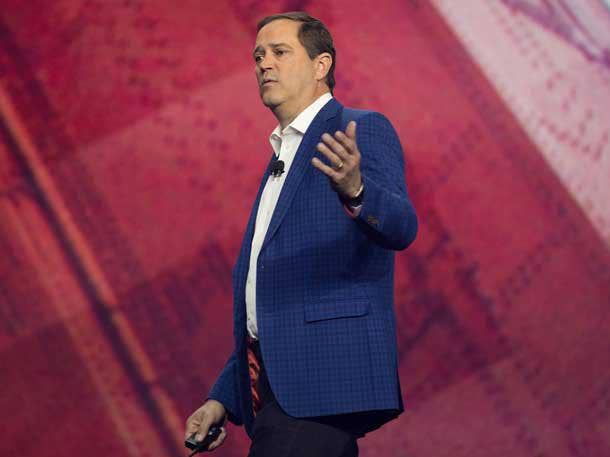Cisco CEO Chuck Robbins: COVID-19 Forcing As-A-Service Transition
The tech giant wants to shift its entire portfolio to a consumption-based model in the wake of the COVID-19 pandemic, which Robbins says builds on the ‘significant transformation’ it has undergone as it focuses on software, services and subscriptions.

Cisco Systems is accelerating its research and development to focus on one goal: delivering everything it can as a service and cutting more than $1 billion in costs.
Cisco Chairman and CEO Chuck Robbins said the COVID-19 pandemic has forced the company to “re-examine” its entire portfolio and nothing is off the table—Cisco wants to transition the majority of its portfolio to an as-a-service consumption model.
The move builds on the “significant transformation” that Cisco has undergone as it shifts its focus to software, services and subscriptions, Robbins said.
Cisco now has 78 percent of its total software revenue sold as subscriptions, beating its target of 66 percent. Robbins said.
“If the past year has taught us anything, it’s the need to always be nimble. I believe that the changes we make to our business now will put us in a position of strength as we focus on the future,” he said.
[Related: The 10 Biggest Cisco News Stories Of 2020 (So Far)]
At the same time, Cisco will be cutting $1 billion in costs to reduce its cost structure over the next few quarters, Robbins said. “We‘re going to rebalance our R&D investments to focus on key areas that will position us well for the future,” he said.
As more businesses lean on the cloud, Cisco will be focusing on cloud security, cloud collaboration, SD-WAN and automation to drive simplicity and cost-effective network management. The company will also invest in 5G, Wi-Fi 6, next-generation silicon and artificial intelligence, Robbins added.
Cisco reported growth in only its security segment during its fiscal fourth quarter as the COVID-19 pandemic continues to squeeze tech revenue around the globe. The segment posted a 10 percent revenue increase year over year, rising to $814 million. For the full year, the security segment rose 12 percent. Cisco in March extended free licenses and expanded usage counts at no extra charge for three of its security technologies—Cisco Umbrella, Cisco‘s Duo Security offering and Cisco AnyConnect Secure Mobility Client—to boost visibility to now even more geographically dispersed businesses.
The San Jose, Calif.-based tech giant‘s product revenue fell 13 percent year over year, while services revenue was flat. However, the company saw growth in its maintenance business and in software and support services. Cisco’s advisory services declined due to the COVID-19 environment, said Cisco CFO Kelly Kramer.
The company‘s applications business segment, which includes AppDynamics and the company’s videoconferencing and collaboration portfolio, fell 9 percent to $1.36 billion in revenue in the fourth quarter, which Kramer attributed to revenue declines in UC endpoints. The applications segment, which declined 4 percent for the full year, saw double-digit Webex growth in the fourth quarter, Kramer said.
Cisco at the beginning of March expanded the capabilities in its free Webex offer in all countries where it is available. The new Webex features include unlimited usage or no time restrictions and support for up to 100 participants. Cisco also provided free 90-day licenses to businesses that were not Webex customers through its sales team and Cisco partners. Now, these free trials are turning into paid subscriptions, Robbins said.
Cisco counts 95 percent of the world‘s Fortune 500 businesses as collaboration customers today. Robbins said Webex is the most trusted collaboration platform for remote enterprises.
Cisco‘s infrastructure segment, which includes the core switching and routing businesses as well as wireless and data center products, continued its double-digit decline, falling 16 percent during the quarter to $6.62 billion. Kramer said that the infrastructure segment was the hardest hit by the pandemic, especially for data center and switching and routing revenue. Overall, this segment dropped 10 percent for the full year.
The silver lining is that Cisco‘s biggest enterprise accounts are still ordering and investing in digital transformation. Midsize and smaller companies, however, are pausing their IT spends, Kramer said. “We have confidence … we feel good about how we’ll come out of this.”
Robbins announced during the earnings call that Kramer, who has been with Cisco for more than eight years, will be retiring after the company can find her successor.
For the fourth fiscal quarter that ended June 30, Cisco‘s revenue declined 9 percent to $12.14 billion from $13.43 billion in the year-ago quarter, with earnings per share declining to 80 cents on a non-GAAP basis. Cisco’s net income declined 5 percent year over year, falling to $3.39 billion from $3.59 billion year over year.
Cisco in July bought Swedish video analytics specialist Modcam to add more intelligence into its Meraki smart camera line to help end users gain more value from the data they collect. The company also this month closed its acquisition of ThousandEyes, a network monitoring and intelligence company.